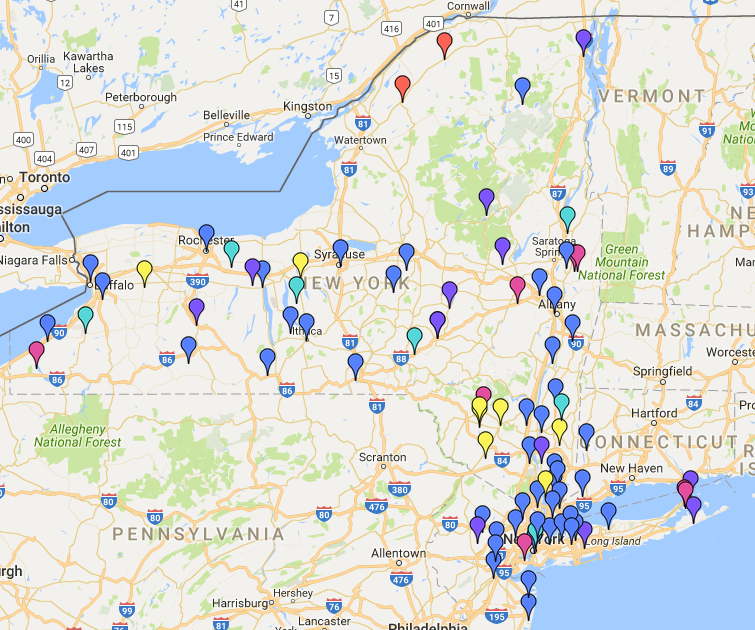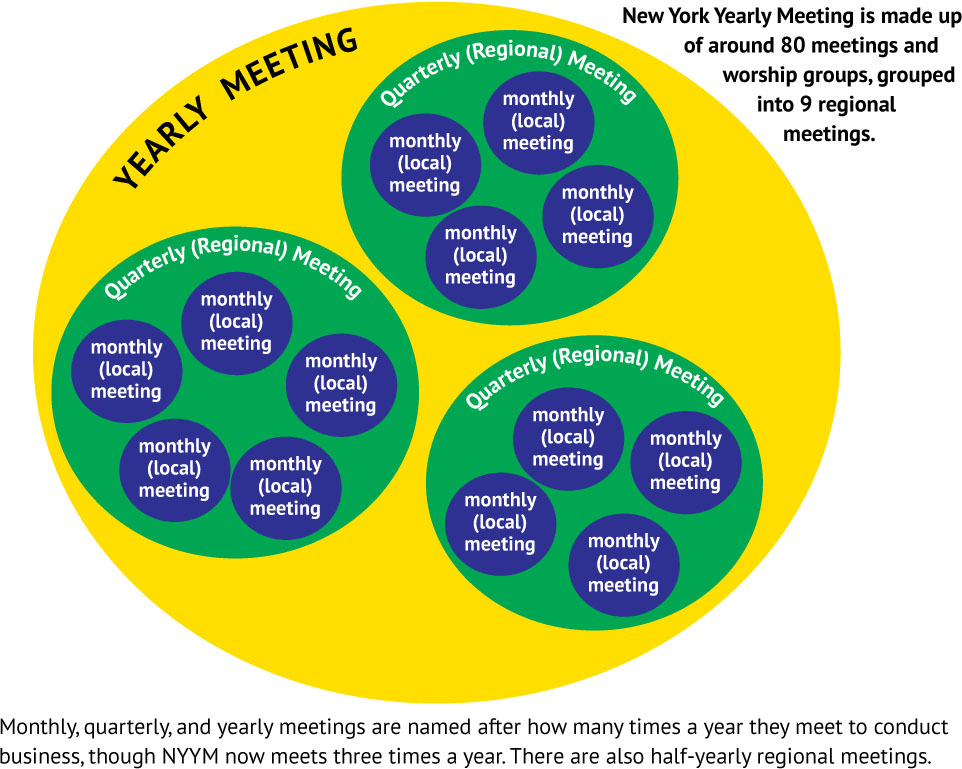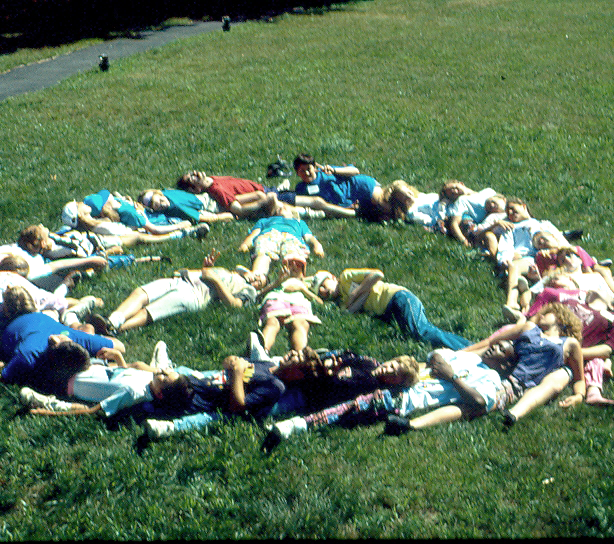Report: Baltimore Yearly Meeting Annual Sessions 2015, Emily Provance
Report on Visit to Baltimore Yearly Meeting Sessions 2015
to New York Yearly Meeting Fall Sessions 2015
submitted by Emily Provance, Fifteenth Street Monthly Meeting
Dear Friends,
Some of you might not know--I certainly didn’t--that Baltimore Yearly Meeting does something really cool. Every summer, they informally ask a number of other yearly meetings to send a representative to their summer sessions, specifically for the purpose of intervisitation. This year, Jeff Hitchcock and Christopher Sammond asked me if I would go. I jumped at the chance, and I spent August 5th through August 9th with Baltimore Friends at Frostburg University in Maryland.
Actually, I’ve done quite a lot of visiting in the past little while. Since March, I’ve been to FWCC’s Section of the Americas (that’s Friends World Committee for Consultation), an event in Ohio sponsored by FUM (that’s Friends United Meeting), FGC’s gathering in North Carolina (Friends General Conference), our own summer sessions at Silver Bay, New England Yearly Meeting’s sessions in New Hampshire, and then Baltimore’s sessions. So while I’m going to focus on Baltimore’s sessions--since that was what I was asked to report on today--I don’t think I can stop myself from also mentioning lessons learned in other places. I’ll try not to let it sound too much like “what I did on my summer vacation.”
I’ll start with the basic stats. Baltimore Yearly Meeting consists of fifty monthly meetings, all unprogrammed, in Virginia, Maryland, Pennsylvania, and the District of Columbia. Like New York Yearly Meeting, Baltimore Yearly Meeting is affiliated with FGC, FUM, and FWCC. Baltimore Yearly Meeting runs two summer camps, which are clearly very dear to Friends’ hearts, but they have no conference center analogous to Powell House, so most adult Baltimore Friends--if they go to retreats at all--go to Philadelphia Yearly Meeting’s Pendle Hill.
Baltimore Yearly Meeting overflows with the gift of hospitality. Baltimore Friends reached out to me by email weeks before their sessions. They helped me plan my travel and met my shuttle van at midnight, after which two Friends walked me across the college campus to my room and even helped me make my bed. Friends sought me out at meals and specifically invited my participation in both business sessions and committee meetings.
Intervisitation has real life in Baltimore Yearly Meeting. Friends there don’t just receive visitors; they also send them. The members of Baltimore Yearly Meeting’s Intervisitation Working Group visit multiple yearly meeting sessions every summer. They also visit one another’s local meetings pretty frequently.
The desire to meet one another and build relationships extends to Baltimore’s approach to the sessions themselves. Each day of the week featured a plenary in which a speaker--often someone from outside Baltimore Yearly Meeting--offered a presentation on either the work of a broader Quaker organization (such as AFSC) or topics related to Friends’ social justice concerns (such as the work of one presenter who has developed a new approach to the study of economics, centered in earthcare).
I didn’t manage to access a full schedule of youth programs and young adult groups in Baltimore. However, in chatting with one of the “adult presences,” I discovered that the teens, at least, have full-day programming in Baltimore Yearly Meeting, starting mid-morning and going into the night. They develop most of their schedule themselves, with adult presences taking part in all of their activities. Baltimore teens hold their own Meeting for Worship with a Concern for Business every night at about ten o’clock. Each age group, starting in middle school, has a clerk that reports to the body on the last day.
Many more things are happening in Baltimore that Friends here might find worthy of note. Their Peace and Social Action Committee (roughly analogous to our Witness Coordinating Committee) is experimenting with ways of using the yearly meeting website to enable monthly meetings to connect with one another and coordinate witness efforts.
Their clerk and interim meeting clerk (two different people, as used to be the case in New York Yearly Meeting) have begun hosting conference calls in which committee clerks can share the work of their committees with one another, to prevent redundancy and to allow for committees to build on one another’s work. The calls also serve as a way for committee clerks to learn more from one another about best practices of clerking.
Baltimore’s approach to writing and revising the committee handbook pages is radically different from our own, and my sense is that it might be considerably more efficient.
And, believe it or not, their business meeting minutes are much longer than ours.
Baltimore Friends had questions for me, too. One Friend was fascinated by our system of covenant donations. Several wanted to know about elders, the function of which is less widely understood in Baltimore. Many asked about our pastoral meetings. A couple wanted to know more about how we manage our State of Society report.
One more thing I found interesting . . . everywhere I went this summer, Friends were talking about their priorities. Most of you know how much time has been devoted to that in New York Yearly Meeting.
Baltimore Yearly Meeting is working on the same thing, although they’re approaching it a bit differently, mostly by looking at their yearly meeting culture; they’ve formed two groups, one called the Growing Diverse Leadership ad hoc working group, the other called the Healthy Organization and Purposeful Evolution Committee. (In case you were frantically trying to figure out that acronym, it spells HOPE.)
New England Yearly Meeting, FWCC’s Section of the Americas, FUM, and FGC are also all in the midst of (or just beginning, or just finishing) considerable restructuring or reprioritizing. What I find strange is that, in all of this work surrounding structure, culture, and organization, there doesn’t seem to be an effort to assemble Friends from all these different groups to ask the bigger--and I think, very relevant--question, “What is God’s purpose for large Quaker bodies?”
On the whole, visiting Baltimore and attending the other gatherings was an overwhelmingly positive and very educational experience. It also allowed for some great cross-pollination.
In Baltimore, I met a Friend who’s exploring the question, “How can the Yearly Meeting Ministry and Counsel Committee best support local meetings?” And I got the chance to come back to New York and put that Friend in contact with someone here who’s asking the very same thing. In New England, I met a Friend who’s been exploring new approaches to the State of Society Report. I connected her to a Friend serving on our own State of Society Committee. At the FUM gathering in Ohio, I met a Friend that I was later able to recommend as a guest speaker at Friends Seminary. And in the van on the way back to the airport following FWCC in Mexico City, I met a Friend who invited me to an outreach roundtable in April in New Hampshire, which inspired the outreach roundtable held at Shrewsbury on October 10th of this year--which 25 Friends from 18 meetings attended.
God is moving in astounding ways through the entire Religious Society of Friends. I am grateful for the chance to bear witness to some of this movement. I have lots more to share . . . but I promised Cindy I would only take ten minutes, so my time is probably up. I’m excited to continue the conversation with anyone who’d like to do so.
This item was presented at





